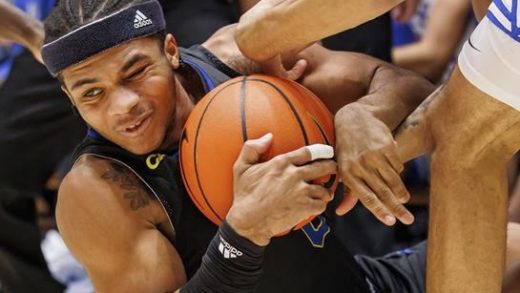The raw numbers themselves are impressive enough, but that picture doesn’t quite tell the whole story.
It merely scratches the surface.
That the Winnipeg Jets have gone 19 consecutive games of allowing three goals or fewer is not only a badge of honour, it’s a massive reason the team sports an 18-9-2 record and is battling for top spot in the Central Division and one of the hottest teams in the NHL right now – winners of six of the past seven games going into Monday’s game against the Montreal Canadiens (with puck drop set for just after 6:30 p.m. CT).
The Jets are in the midst of a four-game homestand and have three games left before the holiday break, including Wednesday against the Detroit Red Wings and Friday against the Boston Bruins.
The last time the Jets gave up more than three goals was in a 5-2 loss to the Vegas Golden Knights on Nov. 2, a span of more than six weeks and one that captures nearly a quarter of the season.
Since a remarkable run to the Western Conference final in 2018, the Jets have been searching for the formula to return there and in the second season under head coach Rick Bowness, the body of work suggests this group is well on the way to figuring things out when it comes to their play without the puck.
“At the end of the day, if your details are right and you’re playing good defensive hockey, you’re always going to have a chance, you’re always going to be in the game,” said Jets defenceman Dylan DeMelo. “Goals go up and down. Guys get hot, get cold, whatever it is. But if you play a good defensive structure and you (limit) a team’s offensive chances, you’re in the game every night. We realize that’s one thing we can control, our defensive structure and our effort and how hard we battle.
“Sometimes the puck is going to go in and sometimes, it’s not. Hockey is sometimes a funny game, with bounces and things like that. But we’re just realizing that for this group, for us to succeed is what we’re trying to do.”
Given some of the well-documented struggles with both the penalty kill and the power play, it’s no surprise the foundation for this group has been its play at even strength.
According to MoneyPuck, the Jets have given up the fewest goals at five-on-five (42), while scoring 65 – good for a goal differential of plus-23.
So how has a team that has occasionally struggled to prevent high-danger scoring chances suddenly turned into a stingier team?
There is a theme that emerged during numerous conversations with Jets players this week.
“It’s a total buy-in right now from everybody,” DeMelo explained. “All of the lines are looking the same without the puck. Everybody is defending hard. I think we trust this game on a more consistent basis than we did last year, in regards to maybe we didn’t fully believe that if we played good enough in the D-zone that we’d get enough looks offensively.
“Where (now), we are getting enough looks offensively. We’re getting enough chances to win every night. We trust it, we realize what works and we’re confident in it. The good thing too, is that we’re patient with it. If we’re not maybe getting offence for stretches in the game, we’re not deviating from it. Where in the past, maybe we thought we’d have to open this up now because we’re not getting any looks.”
In season’s past – and even last season during the swoon that nearly cost the Jets a playoff spot after the best start in franchise history – the Jets weren’t as dedicated to playing that way defensively.
“The thing that has impressed me most is the commitment to it,” said Jets defenceman Neal Pionk. “It’s a mentality, it’s a belief and it’s a buy-in. It’s all three of those things.
“We made a little tweak in the offseason and through training camp and guys have got to go all-in. You can’t have half the guys in and half the guys out.”
That hasn’t been an issue this season, not even after a 1-3 start that could have tested the will of the group.
“If you don’t believe it can work, you won’t buy in,” said Pionk. “We didn’t get the results early, but we knew what our game was. We knew we were playing well, but we didn’t get the results. There’s a big difference. We knew it was going to turn at some point.”
Since his arrival on the scene, Bowness has stressed that he wants the Jets to play an aggressive style and while he knew they needed to be better defensively, he hasn’t asked them to sit back and take a passive approach.
It’s been quite the opposite actually, but it hasn’t resulted in the Jets giving up a plethora of odd-man rushes either because if a defenceman jumps up into the play, there’s almost always a forward filling in his spot.
“It’s high pace, high energy,” said Pionk. “We get the puck moving a little bit, so that’s more fun for players too.”
One of the other things to consider is the significant changes in personnel during the past 50 games to the forward group.
Whether it was the trade-deadline additions of Nino Niederreiter and Vladislav Namestnikov or the summer blockbuster with the Los Angeles Kings that brought back Gabriel Vilardi, Alex Iafallo and Rasmus Kupari, it’s clear the Jets were focused on bringing in some additional two-way talent that is diligent defensively and often hard to play against.
“It always helps when you have more guys playing a two-way game. Then you drag other guys with you,” said Niederreiter, who is flourishing with Adam Lowry and Mason Appleton. “Each and every line has their role and knows exactly what they need to do. That’s why we feed off each other, it feels like. If you look at our line, we try to play the system to a T and hopefully, we get the rest of the lines following us.”
The Lowry line has often been a tone setter and the same can be said for top centre Mark Scheifele, whose commitment to playing a 200-foot game has been an example of his leadership.
There haven’t been many nights where the Jets have built a lead and put things on cruise control either.
“I think we are all on the same page, no matter what line’s out there,” said Namestnikov. “We know what we have to do. We are not taking the foot off the gas when we have the lead, we just keep going.”
On the flip side, not cheating for offence at the expense of defending properly when trailing has also been a factor.
“A lot of it falls back on how we’re plying defensively and stylistically,” said Lowry. “Maybe in the past we’re a little looser defensively. We haven’t been giving up a whole lot at five-on-five and that’s critical. Finding your way, finding yourself down in games, you know that you don’t have to break it open. If you stick to your structure, you can find a way to get a goal and hopefully your special teams can get one and you’re right back in it.”
After going through some challenges and disappointments during the past several seasons, there’s an increased maturity within the group that has been evident this season.
“It’s just continuing to grow,” said Jets defenceman Josh Morrissey. “We look at a lot of guys in our locker room who have been here for quite some time, we’re not young guys anymore, we’re well into our careers. And the guys that have come in as young players are mature and the guys we’ve brought in, through free agency and trades, bring a lot of leadership qualities to our room.
“I just feel that we have a really balanced locker room, a lot of guys with experience and commitment to details in their habits. It’s a long-term approach to the type of culture you want to have. It’s just kind of the whole approach to doing anything you can to trying to be elite, to try and win hockey games and be at your best as much as you can all year. That commitment level has improved immensely this year. It’s not sort of a night-in, night-out once-in-a-while thing. It’s more of an identity that we’re trying to build here. And we feel if we have that, it gives us a chance to be a really good team.”
Strong goaltending from Connor Hellebuyck – who is in the midst of 10 consecutive starts of allowing two goals or fewer – and backup Laurent Brossoit has clearly played a role in the defensive turnaround.
But the netminders aren’t facing the same volume of high-danger chances they’ve been subjected to in the past.
Having that predictability of where the scoring chances are coming from helps the masked men considerably.
However, despite the steps that have already been taken, there’s still some room for improvement on that front, since the Jets have allowed more high-danger chances (263) at even strength than they’ve created (276), according to NaturalStatTrick.
Hellebuyck chooses to focus on the positives and that was no different when he was asked about what he’s seen from the group playing in front of him to this point of the season.
“It shows that everyone in here is realizing that is what it’s going to take to win a Cup and we’re willing to do it,” said Hellebuyck. “That’s the style of play that you want to see.”
And it’s the style of play that will be required during the final 53 games of the regular season and beyond if the Jets are hoping to put together a lengthy playoff run.
X: @WiebesWorld

Ken Wiebe
Sports reporter
Raised in the booming metropolis of Altona, Man., Ken Wiebe grew up wanting to play in the NHL, but after realizing his hands were more adept at typing than scoring, he shifted his attention to cover his favourite sport as a writer.


